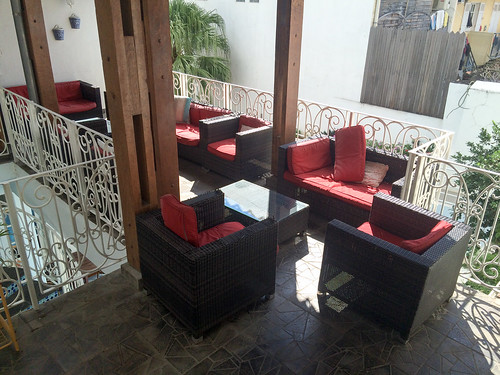Paris (CDG) to Réunion (RUN), Air Austra, Réunion trip report, April 2015
#1
Original Poster
Join Date: Mar 2008
Location: Grantham, NH
Posts: 530
Paris (CDG) to Réunion (RUN), Air Austra, Réunion trip report, April 2015
Last April, I spent two weeks on the French island of Réunion. I had heard several murmurings from people (mostly French) of how wonderful the food and hiking were there, so I decided to pick an unusual destination for this year's early vacation. I figured I'd do a trip report.
(Bear with me, I did this writeup previously for another forum, so it's a bit longer than most trip reports here)
For those not familiar with the island (which, at least here in my part of the US is "most everyone"), I'll start by giving some background on Reunion. Most Americans (heck, most North Americans, and non-French Europeans) aren't particularly familiar with it. Located in the Indian Ocean east of Madagascar, the short version of Reunion's history is that it's in many ways the "French Hawaii". Volcanic in nature, the island was basically unknown and unsettled until the mid-1600s (not having many workable ports or beaches on a rugged, volcanic coastline didn't help), when the French finally established colonies there as the Island of Bourbon (later renamed after the French revolution when the Bourbons weren't all that popular...).
Like many tropical islands, it quickly became exploited by the French East India company, primarily for the growing of a well-prized coffee variety, Bourbon Pointu (coffee with little pointed beans... we'll come back to that later). Much of the arable land of the island was converted to agriculture, primarily growing coffee, with the labor primarily provided by French-imported slaves from Africa, with a smattering of other Indian ocean ethnicities as well. Then, in the late 1700s, a combination of a collapse of the East India company, several bad cyclones (Reunion and Mauritius frequently experience severe cyclones every rainy season), and then the loss of the island to the British in the Napoleonic Wars resulted in the British taking over the island, and replacing the failed coffee plantations wholesale with sugar cane, which to this day is an important cornerstone of the island economy. However, the French regained the island in 1815.
The end of slavery in France in 1848 resulted in a massive labor shortage in the cane fields, and the primary response was a shift to indentured servitude (a practice that lasted until the 1930s). So, like Hawaii, a rather large number of immigrants were brought to the island: primarily from nearby Madagascar (the Malagasy people), but also India (primarily from Pondichery, which to this day is still a heavily-French influenced area of India), China (primarily from Guangzhou, which is likewise still heavily French-influenced), Indonesia, and Portugal. Following the end of World War II (in which the island was nearly completely isolated from the rest of the world and had to massively diversify their agriculture to survive, and build a rum industry for exports), the age of jet transport turned this obscure French colony into a tropical tourism industry. But until 2000 (when direct flights from Paris became common), getting there was still a bit of a challenge, so tourism there is almost completely from France, which makes for some interesting cultural effects, particularly that of being a place that gets almost zero tourism from the Western Hemisphere, and being American is particularly eyebrow-raising (indeed, we were mistaken for South African, German, Australian, and even Brazilian more often than anyone thought were were British or American), and most of the native population had never actually met Americans before.
(Bear with me, I did this writeup previously for another forum, so it's a bit longer than most trip reports here)
For those not familiar with the island (which, at least here in my part of the US is "most everyone"), I'll start by giving some background on Reunion. Most Americans (heck, most North Americans, and non-French Europeans) aren't particularly familiar with it. Located in the Indian Ocean east of Madagascar, the short version of Reunion's history is that it's in many ways the "French Hawaii". Volcanic in nature, the island was basically unknown and unsettled until the mid-1600s (not having many workable ports or beaches on a rugged, volcanic coastline didn't help), when the French finally established colonies there as the Island of Bourbon (later renamed after the French revolution when the Bourbons weren't all that popular...).
Like many tropical islands, it quickly became exploited by the French East India company, primarily for the growing of a well-prized coffee variety, Bourbon Pointu (coffee with little pointed beans... we'll come back to that later). Much of the arable land of the island was converted to agriculture, primarily growing coffee, with the labor primarily provided by French-imported slaves from Africa, with a smattering of other Indian ocean ethnicities as well. Then, in the late 1700s, a combination of a collapse of the East India company, several bad cyclones (Reunion and Mauritius frequently experience severe cyclones every rainy season), and then the loss of the island to the British in the Napoleonic Wars resulted in the British taking over the island, and replacing the failed coffee plantations wholesale with sugar cane, which to this day is an important cornerstone of the island economy. However, the French regained the island in 1815.
The end of slavery in France in 1848 resulted in a massive labor shortage in the cane fields, and the primary response was a shift to indentured servitude (a practice that lasted until the 1930s). So, like Hawaii, a rather large number of immigrants were brought to the island: primarily from nearby Madagascar (the Malagasy people), but also India (primarily from Pondichery, which to this day is still a heavily-French influenced area of India), China (primarily from Guangzhou, which is likewise still heavily French-influenced), Indonesia, and Portugal. Following the end of World War II (in which the island was nearly completely isolated from the rest of the world and had to massively diversify their agriculture to survive, and build a rum industry for exports), the age of jet transport turned this obscure French colony into a tropical tourism industry. But until 2000 (when direct flights from Paris became common), getting there was still a bit of a challenge, so tourism there is almost completely from France, which makes for some interesting cultural effects, particularly that of being a place that gets almost zero tourism from the Western Hemisphere, and being American is particularly eyebrow-raising (indeed, we were mistaken for South African, German, Australian, and even Brazilian more often than anyone thought were were British or American), and most of the native population had never actually met Americans before.
#2
Original Poster
Join Date: Mar 2008
Location: Grantham, NH
Posts: 530
Now, for the good stuff....
Reunion is really a culinary delight. The mix of cultural influences from France, Madagascar, India, China, Portugal, Indonesia, and other locals makes for a particularly vibrant mix of ethnicities, often all blended together in the same meal. Add in the fact that the island has a shockingly wide range of agricultural products of their own (guava, papaya, banana, sugar cane, pineapple, chayottes, and mangos in particularly all grow like, and sometime as, weeds, and there's a strong spice industry as well) makes for some particularly great, and sometime unique, ingredients to work with. There's also enough French influence (the island is actually part of France, not a colony) that if you are on an actual road, you are also guaranteed to be never more than a 20 minute drive from a decent boulangerie or patisserie, even when in the middle of the island in the mountains.
When it comes down to it, however, the foundation of nearly every single menu and meal is the "carri" (curry, also spelled "cari" or "cary"). A variant of the Indian-style curry, it's generally meat simmered in a sauce of tomatoes, onions, garlic, ginger, thyme, turmeric, and saffron, and can be found with just about every type of protein, ranging from chicken (carri poulet), to duck (carri canard), swordfish (carri espadon), shrimp (carri camarons), and even octopus (carri zourite). The carri is, without variation, served up with a mountain of rice, and some sort of simmered bean (lentils and lima beans being the most common). The carri itself is always very heavily spiced... but unlike Indian or Chinese curries, the carri itself is almost never actually hot in flavor: they don't use hot peppers in the carri itself. Much of this is a byproduct of the French not particularly liking hot food. But don't think that there isn't heat... Each carri is also served up with either "piment" (a hot-pepper salsa made with the tiny hot peppers grown locally), or a rougail, a spicy chutney that usually mixes tomato, garlic, ginger, and chile peppers, often with other local ingredients like lemon, lime (including kaffir limes), thyme, mango, and the like. And while a few of the rougails were more tart than hot, a few of them were about as fiery as you can imagine, so only a tiny little dab of rougail was enough to flavor your entire plate. More than a few times, my American Southwest-calibrated palate with many years of Indian and Thai experience surprised the locals with my love of some of their hottest rougails.... but just as many times I found myself having to search out a "carafe d'eau" to put out the fires.
Variants of the carri also exist. Confusingly, a "rougail" can also be the main dish itself, since a carri made with either smoked pork (boucane) or sausages (sausisses) is also known as a "rougail" (e.g. "rougail sausisses"). And there's a civet, with is a stew-like variant of a carri with more vegetables.
Breakfast is pretty much French-standard: bread (both baguettes and proper croissants being common), butter (one of the few French imports that was comment was Breton butter, oddly enough), and jams made from one or more of the island fruits (mango, guava, and pineapple being the most common, often with vanilla or other spices mixed in).
So you'll see that most of my meals consisted of some sort of carri, a big pile of rice, and some lentils and rougail on the side. But wow, the variety...
Reunion is really a culinary delight. The mix of cultural influences from France, Madagascar, India, China, Portugal, Indonesia, and other locals makes for a particularly vibrant mix of ethnicities, often all blended together in the same meal. Add in the fact that the island has a shockingly wide range of agricultural products of their own (guava, papaya, banana, sugar cane, pineapple, chayottes, and mangos in particularly all grow like, and sometime as, weeds, and there's a strong spice industry as well) makes for some particularly great, and sometime unique, ingredients to work with. There's also enough French influence (the island is actually part of France, not a colony) that if you are on an actual road, you are also guaranteed to be never more than a 20 minute drive from a decent boulangerie or patisserie, even when in the middle of the island in the mountains.
When it comes down to it, however, the foundation of nearly every single menu and meal is the "carri" (curry, also spelled "cari" or "cary"). A variant of the Indian-style curry, it's generally meat simmered in a sauce of tomatoes, onions, garlic, ginger, thyme, turmeric, and saffron, and can be found with just about every type of protein, ranging from chicken (carri poulet), to duck (carri canard), swordfish (carri espadon), shrimp (carri camarons), and even octopus (carri zourite). The carri is, without variation, served up with a mountain of rice, and some sort of simmered bean (lentils and lima beans being the most common). The carri itself is always very heavily spiced... but unlike Indian or Chinese curries, the carri itself is almost never actually hot in flavor: they don't use hot peppers in the carri itself. Much of this is a byproduct of the French not particularly liking hot food. But don't think that there isn't heat... Each carri is also served up with either "piment" (a hot-pepper salsa made with the tiny hot peppers grown locally), or a rougail, a spicy chutney that usually mixes tomato, garlic, ginger, and chile peppers, often with other local ingredients like lemon, lime (including kaffir limes), thyme, mango, and the like. And while a few of the rougails were more tart than hot, a few of them were about as fiery as you can imagine, so only a tiny little dab of rougail was enough to flavor your entire plate. More than a few times, my American Southwest-calibrated palate with many years of Indian and Thai experience surprised the locals with my love of some of their hottest rougails.... but just as many times I found myself having to search out a "carafe d'eau" to put out the fires.
Variants of the carri also exist. Confusingly, a "rougail" can also be the main dish itself, since a carri made with either smoked pork (boucane) or sausages (sausisses) is also known as a "rougail" (e.g. "rougail sausisses"). And there's a civet, with is a stew-like variant of a carri with more vegetables.
Breakfast is pretty much French-standard: bread (both baguettes and proper croissants being common), butter (one of the few French imports that was comment was Breton butter, oddly enough), and jams made from one or more of the island fruits (mango, guava, and pineapple being the most common, often with vanilla or other spices mixed in).
So you'll see that most of my meals consisted of some sort of carri, a big pile of rice, and some lentils and rougail on the side. But wow, the variety...
#3
Original Poster
Join Date: Mar 2008
Location: Grantham, NH
Posts: 530
Some quick thoughts/advice for anyone else that wants to visit Reunion:
1. Most English-language travel resources either have nothing on Reunion, or they actual recommend against it due to the language barrier. So you'll spend a lot of time research stuff on the internet, particularly using Google Translate with French-language reviews and travel websites. That said, the Lonely Planet guide was pretty good (it also covers Mauritius and the Seychelles).
2. Don't let the language thing throw you too much. It's 100% true that the vast majority of the Island speaks near-zero English.... but the few English speakers are definitely concentrated in the hospitality industry. That, and we found that everyone on the island was very patient, so between my crappy French (2 years in high school, almost 30 years ago), a phrase book, some pantomiming, and a lot of back and forth (once or twice invoking yet another language, like an innkeeper that knew German well), and once or twice relying on the kindness of fellow travelers (many of the French tourists actually speak English well, although some of them find the local accent and the heavy use of Creole challenging as well), it mostly worked out.
3. It used to be hard to get to, but there are two relatively easy, if long, routes to do it: direct flights from Paris (10.5 hours), or direct flights from London to Mauritius and a short hop over (about 12 hours total). Buying slightly off-peak and long in advance, we found the tickets relatively cheap.
4. A rental car is more or less essential, and I'd really, really, really recommend practicing your stick-shift skills if you live in a non-hilly area. I live in the backwoods of VT/NH, and the roads here are *nothing* in comparison, Reunion is covered with narrow, steep roads with many switchbacks and much spirited driving.
5. Most of the housing on Reunion isn't hotels (there are a few hotels and resorts), but informal guesthouses known as "gites" (pronounced "zheet"), ranging from modest accommodations (a bed with a restroom down the hall, such as some of the mountain gites we stayed in) to fairly elaborate, well-appointed rooms in a house with large common areas and dinner served up with the other guests at a fairly formal, large dinner (a "Table d'Host")
6. Mostly, skip the capital, St Denis. It's crowded, has heavy traffic, and is centered on governmental stuff. It's like downtown Nassau, and that's not a particularly complimentary thing to say. We spent three days there, and realistically, we should have just driven to the other side of the island immediately.
1. Most English-language travel resources either have nothing on Reunion, or they actual recommend against it due to the language barrier. So you'll spend a lot of time research stuff on the internet, particularly using Google Translate with French-language reviews and travel websites. That said, the Lonely Planet guide was pretty good (it also covers Mauritius and the Seychelles).
2. Don't let the language thing throw you too much. It's 100% true that the vast majority of the Island speaks near-zero English.... but the few English speakers are definitely concentrated in the hospitality industry. That, and we found that everyone on the island was very patient, so between my crappy French (2 years in high school, almost 30 years ago), a phrase book, some pantomiming, and a lot of back and forth (once or twice invoking yet another language, like an innkeeper that knew German well), and once or twice relying on the kindness of fellow travelers (many of the French tourists actually speak English well, although some of them find the local accent and the heavy use of Creole challenging as well), it mostly worked out.
3. It used to be hard to get to, but there are two relatively easy, if long, routes to do it: direct flights from Paris (10.5 hours), or direct flights from London to Mauritius and a short hop over (about 12 hours total). Buying slightly off-peak and long in advance, we found the tickets relatively cheap.
4. A rental car is more or less essential, and I'd really, really, really recommend practicing your stick-shift skills if you live in a non-hilly area. I live in the backwoods of VT/NH, and the roads here are *nothing* in comparison, Reunion is covered with narrow, steep roads with many switchbacks and much spirited driving.
5. Most of the housing on Reunion isn't hotels (there are a few hotels and resorts), but informal guesthouses known as "gites" (pronounced "zheet"), ranging from modest accommodations (a bed with a restroom down the hall, such as some of the mountain gites we stayed in) to fairly elaborate, well-appointed rooms in a house with large common areas and dinner served up with the other guests at a fairly formal, large dinner (a "Table d'Host")
6. Mostly, skip the capital, St Denis. It's crowded, has heavy traffic, and is centered on governmental stuff. It's like downtown Nassau, and that's not a particularly complimentary thing to say. We spent three days there, and realistically, we should have just driven to the other side of the island immediately.
#4
Original Poster
Join Date: Mar 2008
Location: Grantham, NH
Posts: 530
Well, the next step was actually getting to Réunion.
You've basically got two choices in getting there: Going direct (Paris, Johannesburg, and Chennai being the only regular service), or going via Mauritius. While Mauritius was fairly feasible (for us, it would have been BOS->LHR->SSR and then a short 30 minute flight to RUN), we decided that the best overall option was the direct flight from Paris. The price was good, we got directly to Réunion, and we had a Paris layover each way. That was the good news.
The bad news is that it's not exactly a short flight, it's 11 hours flight time on a 777-300ER. Due to the relative popularity of Réunion as a French vacation destination (a lot of housing on the West side of Réunion is second homes for mainland French), there's actually a fair amount of competition between Air France/KLM (based in France) and Air Austral (actually based in Réunion, so, like the island, most of you have never heard of it). But Air Austral does the CDG-RUN run three times a day, and had somewhat better pricing than Air France, so we gave them a go.
One of the interesting things about Air Austral is that they've really been trying to find ways to stay competitive with Air France, and one way they've been doing it is with the food (Air France isn't exactly known for their food). On the way there, we got bumped to J-class (basically, because we were Americans), and part of that was getting to pick a meal from their upgraded meal list. The two most attractive options were the "Fresh Seafood Meal" and the "Reunionnaise Creole Meal". We ended up choosing the latter...
And, here's the worst food photography I've done in a while. The lighting was incredibly lousy, and I didn't want to bother with either my dSLR or my backup camera. And it's not necessarily the most photogenic meal I've had, either, instead looking a bit like most airline food:
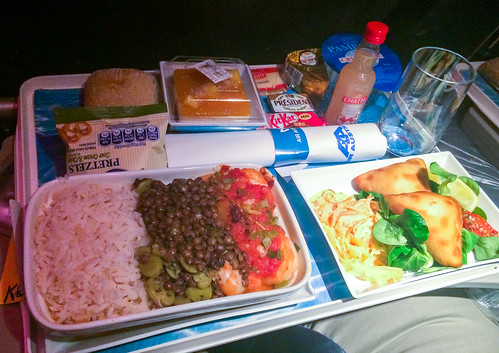
But, despite these shortcomings, I'm sharing this photo since this was the second-best airline meal I've ever had, and the best outside of F-class (that was a reindeer steak on FinnAir in the 1990s). The meal included almost all of the hallmarks of Réunion cuisine:
1. A creole-style Carri Crevettes, with a really rich and powerful (but not hot, see above) cumin and coriander sauce. This dish was particularly notable since the shrimp was actually cooked perfectly, unusual for airline food.
2. A lentil and bean mix with rice
3. A birdesye-pepper and lemon rougail.
4. A scoop of achard (creole cole-slaw like shredded veggie mix with a turmeric sauce)
5. Two very good pork and hot pepper samousas
6. Decent bread
7. Breton butter
8. A mango and pineapple dessert
9. Rhum arrange (a bottled punch from Charrette)
You know, this was my first meal that purported to be authentic Réunion food, and it didn't disappoint. (On the return trip, we opted to pay $9 each for the same meal class as an upgrade).
A mere 9 hours after that dinner was served, after a few odd events, like being asked to close the window blinds as we flew over Libya, we landed mid-morning at the quite scenic Roland Garros International Airport:

You've basically got two choices in getting there: Going direct (Paris, Johannesburg, and Chennai being the only regular service), or going via Mauritius. While Mauritius was fairly feasible (for us, it would have been BOS->LHR->SSR and then a short 30 minute flight to RUN), we decided that the best overall option was the direct flight from Paris. The price was good, we got directly to Réunion, and we had a Paris layover each way. That was the good news.
The bad news is that it's not exactly a short flight, it's 11 hours flight time on a 777-300ER. Due to the relative popularity of Réunion as a French vacation destination (a lot of housing on the West side of Réunion is second homes for mainland French), there's actually a fair amount of competition between Air France/KLM (based in France) and Air Austral (actually based in Réunion, so, like the island, most of you have never heard of it). But Air Austral does the CDG-RUN run three times a day, and had somewhat better pricing than Air France, so we gave them a go.
One of the interesting things about Air Austral is that they've really been trying to find ways to stay competitive with Air France, and one way they've been doing it is with the food (Air France isn't exactly known for their food). On the way there, we got bumped to J-class (basically, because we were Americans), and part of that was getting to pick a meal from their upgraded meal list. The two most attractive options were the "Fresh Seafood Meal" and the "Reunionnaise Creole Meal". We ended up choosing the latter...
And, here's the worst food photography I've done in a while. The lighting was incredibly lousy, and I didn't want to bother with either my dSLR or my backup camera. And it's not necessarily the most photogenic meal I've had, either, instead looking a bit like most airline food:

But, despite these shortcomings, I'm sharing this photo since this was the second-best airline meal I've ever had, and the best outside of F-class (that was a reindeer steak on FinnAir in the 1990s). The meal included almost all of the hallmarks of Réunion cuisine:
1. A creole-style Carri Crevettes, with a really rich and powerful (but not hot, see above) cumin and coriander sauce. This dish was particularly notable since the shrimp was actually cooked perfectly, unusual for airline food.
2. A lentil and bean mix with rice
3. A birdesye-pepper and lemon rougail.
4. A scoop of achard (creole cole-slaw like shredded veggie mix with a turmeric sauce)
5. Two very good pork and hot pepper samousas
6. Decent bread
7. Breton butter
8. A mango and pineapple dessert
9. Rhum arrange (a bottled punch from Charrette)
You know, this was my first meal that purported to be authentic Réunion food, and it didn't disappoint. (On the return trip, we opted to pay $9 each for the same meal class as an upgrade).
A mere 9 hours after that dinner was served, after a few odd events, like being asked to close the window blinds as we flew over Libya, we landed mid-morning at the quite scenic Roland Garros International Airport:

#5
Original Poster
Join Date: Mar 2008
Location: Grantham, NH
Posts: 530
Okay, on to St Denis.
Anyone here been to Nassau? St Denis struck me as being much like Nassau, although somewhat more happening (Nassau got beat up pretty badly by a lot of tourism moving over to Atlantis and "Paradise Island"). But the overwhelming theme is "Colonial administrative" town, with a lot of older Colonial architecture, tight roads, and the like. But it's still a pretty nice little town:
Here's the waterfront, which is mostly a nice park with a combination of palm and tamarind trees:
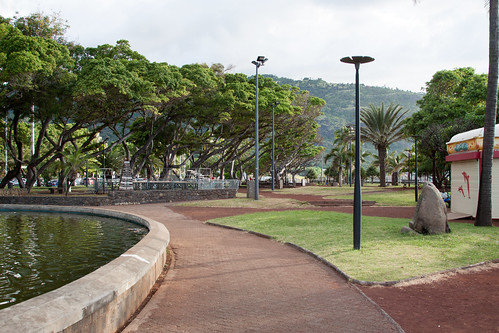
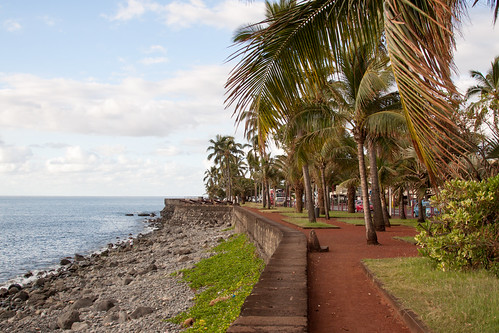
The colonial architecture can best be summed up with the Hotel de Ville, the old City Hall:

As a byproduct of the fact that a lot of places are seasonal occupancy, and that in the rainy season Reunion often gets hit by very severe cyclones, a prominent feature in Reunionnaise architectures is the use of very heavy duty storm shutters (with a funky latching mechanism that I forgot to photograph in detail):

The city is centered about the War Memorial, (WWI), which makes a decent landmark:
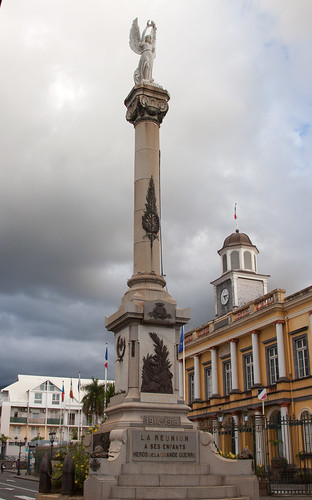
Anyone here been to Nassau? St Denis struck me as being much like Nassau, although somewhat more happening (Nassau got beat up pretty badly by a lot of tourism moving over to Atlantis and "Paradise Island"). But the overwhelming theme is "Colonial administrative" town, with a lot of older Colonial architecture, tight roads, and the like. But it's still a pretty nice little town:
Here's the waterfront, which is mostly a nice park with a combination of palm and tamarind trees:


The colonial architecture can best be summed up with the Hotel de Ville, the old City Hall:

As a byproduct of the fact that a lot of places are seasonal occupancy, and that in the rainy season Reunion often gets hit by very severe cyclones, a prominent feature in Reunionnaise architectures is the use of very heavy duty storm shutters (with a funky latching mechanism that I forgot to photograph in detail):

The city is centered about the War Memorial, (WWI), which makes a decent landmark:

#6
Original Poster
Join Date: Mar 2008
Location: Grantham, NH
Posts: 530
A common theme most anywhere on the island is that of steep volcanic mountains and hillsides, and Saint-Denis is no exception, the West side of town is pretty much defined by a giant, steep mountain: (that, like many things in Reunion, has no specific name, just being called "La Montagne")
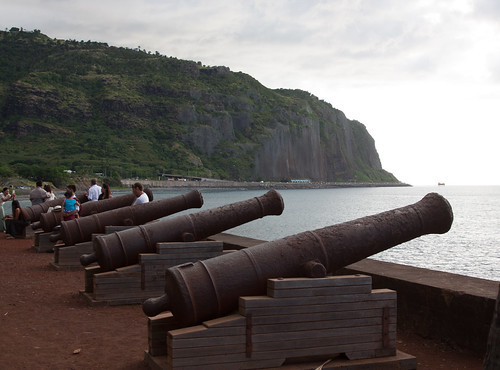
The rare picture of myself from my own camera (looking a bit worn after my flights):
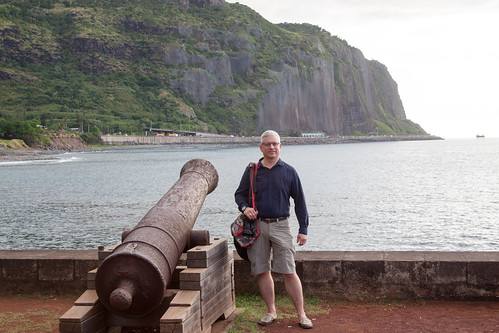
Despite a bit of the European or Caribbean feeling to the town, you quickly can tell that you aren't in one of these areas, since Reunion has a pretty sizeable Muslim population, so in the larger cities (Saint-Denis and Saint-Pierre), you can see the Mosques and hear the calls to prayer, with you here being able to see the Saint-Denis Mosque looming over one of the pedestrian malls in Saint-Denis.
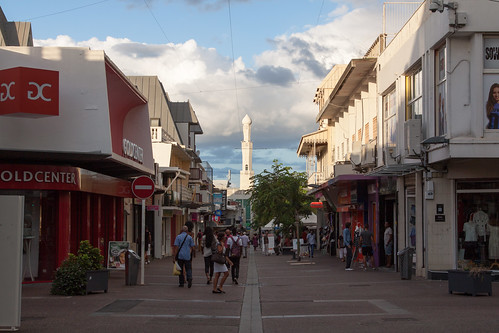
The town also has possible the most non-descript McD's I've ever seen (which, oddly, was selling something called the "Chicago Supreme Burger"):
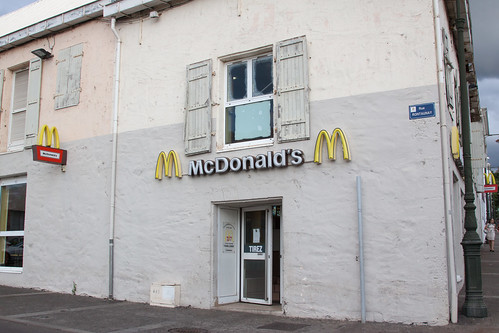

The rare picture of myself from my own camera (looking a bit worn after my flights):

Despite a bit of the European or Caribbean feeling to the town, you quickly can tell that you aren't in one of these areas, since Reunion has a pretty sizeable Muslim population, so in the larger cities (Saint-Denis and Saint-Pierre), you can see the Mosques and hear the calls to prayer, with you here being able to see the Saint-Denis Mosque looming over one of the pedestrian malls in Saint-Denis.

The town also has possible the most non-descript McD's I've ever seen (which, oddly, was selling something called the "Chicago Supreme Burger"):

#7
Original Poster
Join Date: Mar 2008
Location: Grantham, NH
Posts: 530
#8
Original Poster
Join Date: Mar 2008
Location: Grantham, NH
Posts: 530
Now, let's talk a bit about drinking in Réunion.
First, let's talk Beer. First of all, while much of the world has been undergoing the Craft Beer Revolution[tm], it's definitely not happening in Réunion. When it comes down to it, there are basically four different beer brewers doing business in Réunion:
1. Brasserie Bourbon (Saint-Denis)
2. Fischer (Alsace, mainland France)
3. Picaro (Saint-Pierre)
4. Phoenix ("The Beer that Made Mauritius Famous")
So you don't go to Réunion for beer tourism.
You can also occasionally track down a few other niche beers, like Guinness or various Belgian beers (Leffe wasn't uncommon). and I never actually tracked down a Picaro when I was thirsty for a beer, but I did try the others. Of these, I actually enjoyed Bourbon, aka, "La Dodo" (note that their logo is a white dodo[1]). This wasn't a fancy craft beer, but being basically your standard Budweiser-style lager. But it, and some of their secondary varieties (like their darker "Heritage" beer), were pretty good. Here we are enjoying two Dodo's at Cafe Edouard, one of Saint-Denis' more popular watering holes:
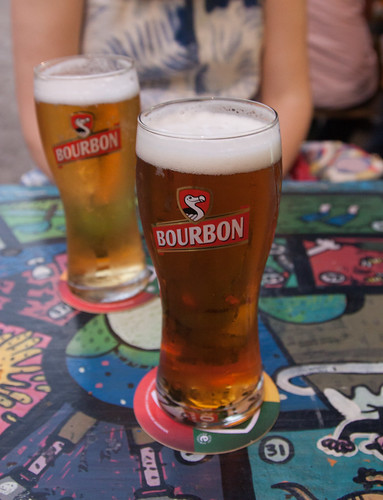
But what "La Dodo" has is a fanatical following on the Island, to the extent I've seen with few other beers (Jamaica's Red Stripe is the only one I've seen even close). The brand is truly iconic, in that most any restaurant, cafe, or "snack bar"[3] will have the the distinctive dodo logo advertised in red, green and yellow in murals (often taking up an entire exterior wall of the joint), outside cafés, table umbrellas, shop windows, signposts, coasters, and the like, all proclaiming "La Dodo Lé La!" ("The Dodo is here!")[4]. I'll try and post some examples as they come up, since it was really impressive how often you'd see the dodo around.
Also, that table above is worth commenting on. Some artist made it for Cafe Edouard, and it's basically a boardgame showing all of the iconic toursit activities of Réunion. I would have taken more pictures if I had fully realized how funny, sarcastic, or stereoptypical some of them were:
1. Getting attacked by sharks
2. Trail-running across the mountains
3. Buying vanilla beans
4. Cutting yourself accidentally with a machete
5. Getting chikungunya disease
6. Eating too much "piment"
7. Not seeing anything because of the cloud layer....
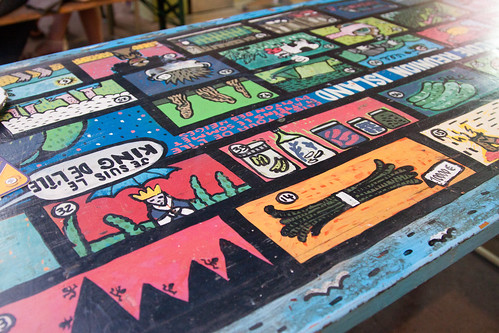
[1] Note that Reunion is not thought to ever have actually had dodos, those being native to nearby Mauritius[2]
[2] However, there were erroneous reports early in the exploration of the region claiming white dodos were on Réunion
[3] One of those odd English phrases that has somehow defied the French tendency to avoid loanwords.
[4] My French coworker informs me there's also a double-entendre here, in that "dodo" is also French baby-speak for "naptime".
First, let's talk Beer. First of all, while much of the world has been undergoing the Craft Beer Revolution[tm], it's definitely not happening in Réunion. When it comes down to it, there are basically four different beer brewers doing business in Réunion:
1. Brasserie Bourbon (Saint-Denis)
2. Fischer (Alsace, mainland France)
3. Picaro (Saint-Pierre)
4. Phoenix ("The Beer that Made Mauritius Famous")
So you don't go to Réunion for beer tourism.
You can also occasionally track down a few other niche beers, like Guinness or various Belgian beers (Leffe wasn't uncommon). and I never actually tracked down a Picaro when I was thirsty for a beer, but I did try the others. Of these, I actually enjoyed Bourbon, aka, "La Dodo" (note that their logo is a white dodo[1]). This wasn't a fancy craft beer, but being basically your standard Budweiser-style lager. But it, and some of their secondary varieties (like their darker "Heritage" beer), were pretty good. Here we are enjoying two Dodo's at Cafe Edouard, one of Saint-Denis' more popular watering holes:

But what "La Dodo" has is a fanatical following on the Island, to the extent I've seen with few other beers (Jamaica's Red Stripe is the only one I've seen even close). The brand is truly iconic, in that most any restaurant, cafe, or "snack bar"[3] will have the the distinctive dodo logo advertised in red, green and yellow in murals (often taking up an entire exterior wall of the joint), outside cafés, table umbrellas, shop windows, signposts, coasters, and the like, all proclaiming "La Dodo Lé La!" ("The Dodo is here!")[4]. I'll try and post some examples as they come up, since it was really impressive how often you'd see the dodo around.
Also, that table above is worth commenting on. Some artist made it for Cafe Edouard, and it's basically a boardgame showing all of the iconic toursit activities of Réunion. I would have taken more pictures if I had fully realized how funny, sarcastic, or stereoptypical some of them were:
1. Getting attacked by sharks
2. Trail-running across the mountains
3. Buying vanilla beans
4. Cutting yourself accidentally with a machete
5. Getting chikungunya disease
6. Eating too much "piment"
7. Not seeing anything because of the cloud layer....

[1] Note that Reunion is not thought to ever have actually had dodos, those being native to nearby Mauritius[2]
[2] However, there were erroneous reports early in the exploration of the region claiming white dodos were on Réunion
[3] One of those odd English phrases that has somehow defied the French tendency to avoid loanwords.
[4] My French coworker informs me there's also a double-entendre here, in that "dodo" is also French baby-speak for "naptime".
#9
Original Poster
Join Date: Mar 2008
Location: Grantham, NH
Posts: 530
Okay, now let's talk about rum. Or "rhum", en Francais....
As I mentioned earlier, sugar cane is the single largest agricultural product on the island. And quite frankly, not a lot of it actually becomes, well, table sugar. Instead, a substantial fraction is involved in the production of rum. While back in older times there were over 30 distilleries on the island, between scaling back, modernization, and other factors, there are only three distilleries on the island now, but they are pretty substantial in size: Savanna, Rivière-du-Mât, and Isautier. They also run a cooperative that produces the largest single brand of rum on the island, a brand called Charrette.
But while there's quite the interest in the rum itself, with many different varieties (in Réunion, they make a distinction between "Rhum Traditionnel" fermented and distilled from molasses and "Rhum Agricole" fermented and distilled directly from cane juice), the majority of the rum, particular the Rhum Charrette, isn't directly consumed, but is instead used to make what's basically the drink of Réunion: the "Rhum arrangé":

At least as common as the abovementioned Dodo, it's expected that pretty much every place of hospitality on the island (hotels, bars, restaurants, snack bars, mountain guest huts and, in one spot, even a taxicab stand) offer up some sort of rhum arrangé: rum infused with sugar and macerated with mixture of local herbs, fruits, and spices, often with some sort of special "house mix". Then it's generally served up to you in small portions, such as little 2 centiliter cups.
I was really impressed with a lot of mixtures. Some of them are pretty predictable, like "Fruits de passions"... but a lot of them were more inventive than that. Pineapple. Guava. Vanilla beans (another island industry). Tea. Orchid Leaves, which have a particularly unique flavor. "Quatorze epices" (14 spices). Star anise. Tamarind. Cinnamon. Hot peppers (always, always, accompanied by severe warnings, the French not being particularly accustomed to chile pepper heat).
It really is quite the tradition, and quite expected, for there to be at least one bottle of rhum arrangé brought forth at the end of the evening (indeed, pretty much universal at every place we stayed except for the guest house run by a Muslim family... and that includes the mountain gîtes far from the nearest trailhead).
(More on this later when I get to my visit to Le Saga du Rhum, the rum museum)
As I mentioned earlier, sugar cane is the single largest agricultural product on the island. And quite frankly, not a lot of it actually becomes, well, table sugar. Instead, a substantial fraction is involved in the production of rum. While back in older times there were over 30 distilleries on the island, between scaling back, modernization, and other factors, there are only three distilleries on the island now, but they are pretty substantial in size: Savanna, Rivière-du-Mât, and Isautier. They also run a cooperative that produces the largest single brand of rum on the island, a brand called Charrette.
But while there's quite the interest in the rum itself, with many different varieties (in Réunion, they make a distinction between "Rhum Traditionnel" fermented and distilled from molasses and "Rhum Agricole" fermented and distilled directly from cane juice), the majority of the rum, particular the Rhum Charrette, isn't directly consumed, but is instead used to make what's basically the drink of Réunion: the "Rhum arrangé":

At least as common as the abovementioned Dodo, it's expected that pretty much every place of hospitality on the island (hotels, bars, restaurants, snack bars, mountain guest huts and, in one spot, even a taxicab stand) offer up some sort of rhum arrangé: rum infused with sugar and macerated with mixture of local herbs, fruits, and spices, often with some sort of special "house mix". Then it's generally served up to you in small portions, such as little 2 centiliter cups.
I was really impressed with a lot of mixtures. Some of them are pretty predictable, like "Fruits de passions"... but a lot of them were more inventive than that. Pineapple. Guava. Vanilla beans (another island industry). Tea. Orchid Leaves, which have a particularly unique flavor. "Quatorze epices" (14 spices). Star anise. Tamarind. Cinnamon. Hot peppers (always, always, accompanied by severe warnings, the French not being particularly accustomed to chile pepper heat).
It really is quite the tradition, and quite expected, for there to be at least one bottle of rhum arrangé brought forth at the end of the evening (indeed, pretty much universal at every place we stayed except for the guest house run by a Muslim family... and that includes the mountain gîtes far from the nearest trailhead).
(More on this later when I get to my visit to Le Saga du Rhum, the rum museum)
#10
Original Poster
Join Date: Mar 2008
Location: Grantham, NH
Posts: 530
After two days of exploring the coastal area, it was time to head inland.
The Western part of Reunion was basically one giant volcano (now call Piton des neiges, or "Snow Peak"), but the caldera of that volcano collapsed long ago, leaving three sub-calderas known as Les Cirques (Salazie, Mafate, and Cilaos). Two of these, Cirque de Salazie and Cirque de Cilaos, can be driven into via twisty roads, so we decided to head up into the Cirque de Salazie to the town of Hell-Bourg to check it out.
As you can see, the volcanic nature of Reunion makes for some impressively-steep valleys and mountains. Here we are halfway up the valley to Salazie, looking inward:
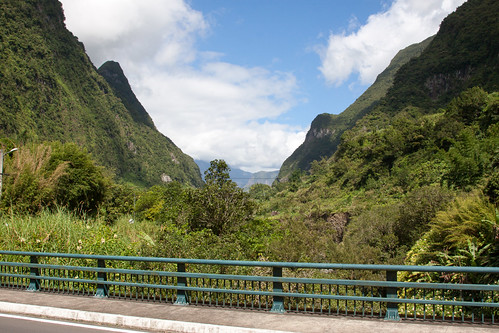
The entire left-hand side of the valley is basically nothing but waterfalls (Cascade du Voile de la Mariée):
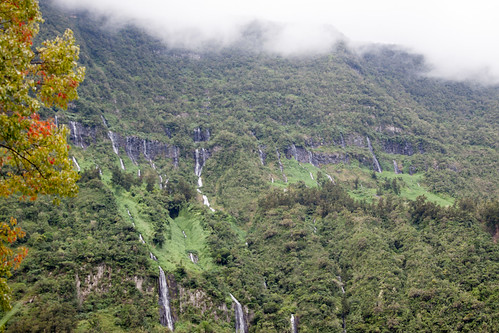
After a long and twisty drive up the canyons, you arrive at the center of Cirque de Salazie, with a stunning view of the small mountain in the center of the caldera, Piton d'Enchaing:
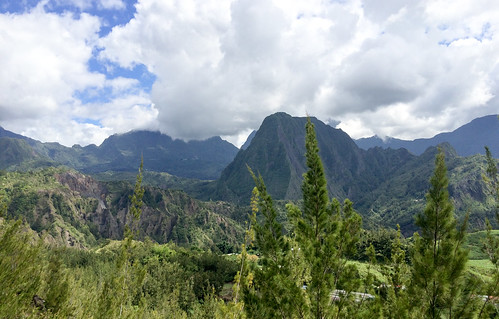
At the center of the Cirque de Salazie is Hell-Bourg, one of the most charming and scenic little French towns I've encountered.
Pictures do not do this place justice:
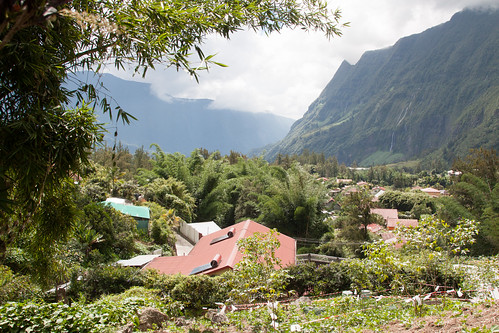

The Western part of Reunion was basically one giant volcano (now call Piton des neiges, or "Snow Peak"), but the caldera of that volcano collapsed long ago, leaving three sub-calderas known as Les Cirques (Salazie, Mafate, and Cilaos). Two of these, Cirque de Salazie and Cirque de Cilaos, can be driven into via twisty roads, so we decided to head up into the Cirque de Salazie to the town of Hell-Bourg to check it out.
As you can see, the volcanic nature of Reunion makes for some impressively-steep valleys and mountains. Here we are halfway up the valley to Salazie, looking inward:

The entire left-hand side of the valley is basically nothing but waterfalls (Cascade du Voile de la Mariée):

After a long and twisty drive up the canyons, you arrive at the center of Cirque de Salazie, with a stunning view of the small mountain in the center of the caldera, Piton d'Enchaing:

At the center of the Cirque de Salazie is Hell-Bourg, one of the most charming and scenic little French towns I've encountered.
Pictures do not do this place justice:


#11
Original Poster
Join Date: Mar 2008
Location: Grantham, NH
Posts: 530
The Cirque de Salazie has very, very heavy vegetation, and one thing that was pretty common was a vine that was overgrowing a good chunk of the trees and bushes (much like kudzu in the US South). But looking at it, we were surprised to find that we had seen this before....
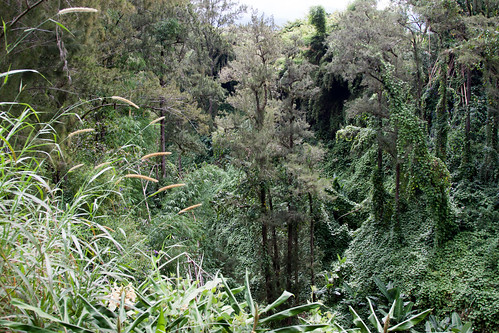
...The vines were all growing what the Reunionnaise call "Chouchou". Also known as the "Chayotte", "Mirliton", or the "Bitter Pear", it's a member of the cucumber family, producing a fruit that's a bit cucumber like and a bit gourd like.
It's also a common ingredient in many different Creole foods (not just Reunion Creole, but Haitian and New Orleans Creole as well)
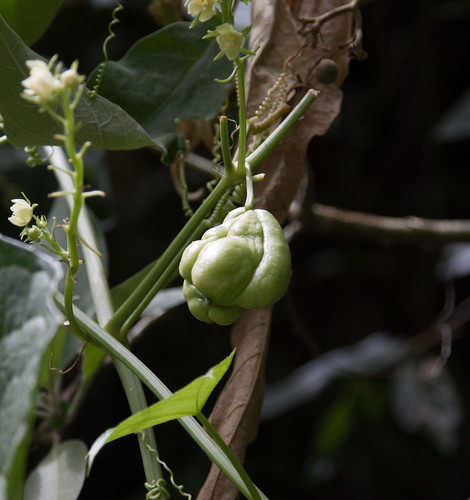

...The vines were all growing what the Reunionnaise call "Chouchou". Also known as the "Chayotte", "Mirliton", or the "Bitter Pear", it's a member of the cucumber family, producing a fruit that's a bit cucumber like and a bit gourd like.
It's also a common ingredient in many different Creole foods (not just Reunion Creole, but Haitian and New Orleans Creole as well)

#12
Original Poster
Join Date: Mar 2008
Location: Grantham, NH
Posts: 530
In Hell-Bourg, we started to become hungry for lunch, and we immediately found the cute little Crêperie Le Gall. As I mentioned a few posts back, there are times when it’s obvious that Réunion is a tropical island, and times when it appears to be a little version of mainland France, and the presence of many crêperies is a good example of the latter, with Crêperie Le Gall having the quaint little interior, large crêpe irons, and the basic sweet and savory menus that I’ve grown to accept from most any authentic crêperie.


But there was one little difference: being Réunion, this crêperie featured the local ingredients. Most of the dessert crêpes features the tropical fruits of the island (mango, pineapple, banana, …). But the savory crêpes did so as well, with the best example being the Ti Chouchou: ham, bechamel sauce, gruyere, and sliced poached chouchou. The above-mentioned chouchou is practically (and may in many cases actually be) a weed, with the long, 30 foot chouchou vines growing wild all over the island, particular in the lush valley of the Cirque de Salazie. Being a fan of the chouchou in it’s Louisiana Creole uses, I figured we give it a try here as well, and we soon found ourselves looking at a delicious pair of crêpes: one ham, and one chouchou.

These were seriously good crêpes: the crêpes themselves were the light and crispy buckwheat wafers that I’ve learned to appreciate from a good crêperie, since they are so hard to make myself. The fillings were both delicious, with the chouchou crêpe being the star: the lightly poached slices of chouchou lent a flavor and texture to the crepe that was approximately halfway between “potato” and “pear”, with just a bit of spiciness.
Additionally, the staff at Crêperie Le Gall was particularly friendly, especially when they found out we were American (unlike many places I’ve been where American tourists are disliked, in Réunion we were an extremely rare novelty, and people were truly pleased that we had sought out a place like Réunion for our vacation. The friendliness more than made up for the occasional language difficulties).


But there was one little difference: being Réunion, this crêperie featured the local ingredients. Most of the dessert crêpes features the tropical fruits of the island (mango, pineapple, banana, …). But the savory crêpes did so as well, with the best example being the Ti Chouchou: ham, bechamel sauce, gruyere, and sliced poached chouchou. The above-mentioned chouchou is practically (and may in many cases actually be) a weed, with the long, 30 foot chouchou vines growing wild all over the island, particular in the lush valley of the Cirque de Salazie. Being a fan of the chouchou in it’s Louisiana Creole uses, I figured we give it a try here as well, and we soon found ourselves looking at a delicious pair of crêpes: one ham, and one chouchou.

These were seriously good crêpes: the crêpes themselves were the light and crispy buckwheat wafers that I’ve learned to appreciate from a good crêperie, since they are so hard to make myself. The fillings were both delicious, with the chouchou crêpe being the star: the lightly poached slices of chouchou lent a flavor and texture to the crepe that was approximately halfway between “potato” and “pear”, with just a bit of spiciness.
Additionally, the staff at Crêperie Le Gall was particularly friendly, especially when they found out we were American (unlike many places I’ve been where American tourists are disliked, in Réunion we were an extremely rare novelty, and people were truly pleased that we had sought out a place like Réunion for our vacation. The friendliness more than made up for the occasional language difficulties).
#13
Original Poster
Join Date: Mar 2008
Location: Grantham, NH
Posts: 530
And our last meal in Saint-Denis before leaving for the Western side of the island had the goal of making sure we tried one of the restaurants known for local Créole cuisine. In the case of Saint-Denis, there’s one place that has a particularly good reputation for catering to Créole tastes over those of visiting tourists, and that’s Le Reflet des Îles.
Located about half a kilometer down Rue Pasteur (where about half of downtown Saint-Denis’s bars and restaurants are located) from the previously reviewed Zanzibar Café, just walking in you can see that it’s a popular place with both the tourists and the locals, with quite a few mainland French and Reunionnaise families all gathered around tables enjoying their rhum cocktails, la Dodo, and serving up large plates of food from various marmites (little cast metal pots traditionally used to cook the local carris, civets, and rougails) located all around the table.
So, basically, the menu at Le Reflet des Îles is “Réunion Créole”, and they’ve got a good representation of the classics (and, very unusually for a Réunion place, Le Reflet had one of the only English-language menus we saw, even if it was a classic of automatic translation) . Including rum drinks, starting off with a Ti Punch. The second-most popular drink in Reunion (after the Rhum Arrange), it’s a simple cocktail made with rhum agricole, lime, and cane syrup. While it looks fruity, it’s not, the color comes from the rhum and the cane syrup. In any case, a perfect start to the meal:

Next was a heart of palm salad. I’ve had many of these in life, usually made with canned heart of palm, and being on an island where ordering heart of palm actually involves them lugging out the giant heart of palm and shaving it to order, it does make for a particularly good rendition of the classic salad. This was also Carol’s first time try it, and she rather enjoyed it, although we both recognized that it’s not exactly an example of sustainable island agriculture (cultivating palms for heart of palm is pretty resource intensive):

And in our last review, I mentioned the Réunionnaise love of charcuturie… I continued my sausage explorations here with a particularly nice Boudin Créole (blood sausage) served up with an achard. Both halves of this dish were delicious: the blood sausage was particularly spicy and flavorful, and probably tied with the blood sausages (morcillas) that we had in Valencia at El Rall several years back. The achard was no slouch, either, being a particularly flavorful mix of cabbage and vegetables in a rich and tangy pickling sauce just oozing with turmeric, making a nice counterpoint to the blood sausage. It reminded a lot of the “curtido” (pickled carrots and cabbage) I’ve had at a lot of Salvadoran places. I’d get this again in a minute:
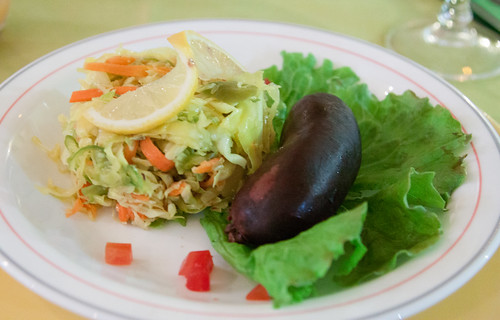
And for my main meal, I picked one of the cornerstones of Réunionnaise cuisine: Carri Porc. Like the previous Carris I’ve had, this was a marmite pot full of chunks of perfectly simmered pork (much like a good Carnitas) in the traditional Réunionnaise carri sauce. Like an Indian curry, it’s based on a mixture of onions, garlic, and ginger. But it’s also got the marks of Réunion flavors, with a lot of turmeric, a lot of thyme, and the local “Quatre Epices” (Four spices), which isn’t actually four spices, but the leaves of the pimenta dioica tree. You may know it better as “allspice”, but the Réunion name comes from the leaves tasting a bit like clove, ginger, nutmeg, and pepper. All of these spices applied liberally, but like I mentioned in my overview, there’s a distinct lack of hot pepper here, that being reserved for the rougail served alongside it: in this case, a pleasant mixture of onions, red pepper, vinegar, ginger, and lime. The result was a particularly pleasing carri, which, after plating up with a healthy dose of the rougail, was just the sort of spicy meal I was looking for:

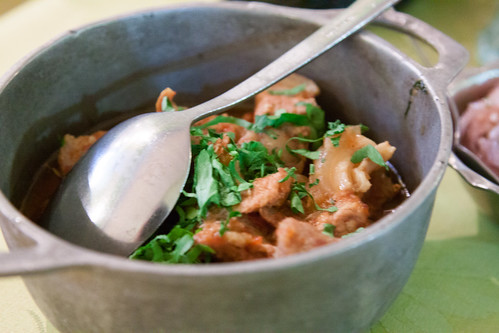
Located about half a kilometer down Rue Pasteur (where about half of downtown Saint-Denis’s bars and restaurants are located) from the previously reviewed Zanzibar Café, just walking in you can see that it’s a popular place with both the tourists and the locals, with quite a few mainland French and Reunionnaise families all gathered around tables enjoying their rhum cocktails, la Dodo, and serving up large plates of food from various marmites (little cast metal pots traditionally used to cook the local carris, civets, and rougails) located all around the table.
So, basically, the menu at Le Reflet des Îles is “Réunion Créole”, and they’ve got a good representation of the classics (and, very unusually for a Réunion place, Le Reflet had one of the only English-language menus we saw, even if it was a classic of automatic translation) . Including rum drinks, starting off with a Ti Punch. The second-most popular drink in Reunion (after the Rhum Arrange), it’s a simple cocktail made with rhum agricole, lime, and cane syrup. While it looks fruity, it’s not, the color comes from the rhum and the cane syrup. In any case, a perfect start to the meal:

Next was a heart of palm salad. I’ve had many of these in life, usually made with canned heart of palm, and being on an island where ordering heart of palm actually involves them lugging out the giant heart of palm and shaving it to order, it does make for a particularly good rendition of the classic salad. This was also Carol’s first time try it, and she rather enjoyed it, although we both recognized that it’s not exactly an example of sustainable island agriculture (cultivating palms for heart of palm is pretty resource intensive):

And in our last review, I mentioned the Réunionnaise love of charcuturie… I continued my sausage explorations here with a particularly nice Boudin Créole (blood sausage) served up with an achard. Both halves of this dish were delicious: the blood sausage was particularly spicy and flavorful, and probably tied with the blood sausages (morcillas) that we had in Valencia at El Rall several years back. The achard was no slouch, either, being a particularly flavorful mix of cabbage and vegetables in a rich and tangy pickling sauce just oozing with turmeric, making a nice counterpoint to the blood sausage. It reminded a lot of the “curtido” (pickled carrots and cabbage) I’ve had at a lot of Salvadoran places. I’d get this again in a minute:

And for my main meal, I picked one of the cornerstones of Réunionnaise cuisine: Carri Porc. Like the previous Carris I’ve had, this was a marmite pot full of chunks of perfectly simmered pork (much like a good Carnitas) in the traditional Réunionnaise carri sauce. Like an Indian curry, it’s based on a mixture of onions, garlic, and ginger. But it’s also got the marks of Réunion flavors, with a lot of turmeric, a lot of thyme, and the local “Quatre Epices” (Four spices), which isn’t actually four spices, but the leaves of the pimenta dioica tree. You may know it better as “allspice”, but the Réunion name comes from the leaves tasting a bit like clove, ginger, nutmeg, and pepper. All of these spices applied liberally, but like I mentioned in my overview, there’s a distinct lack of hot pepper here, that being reserved for the rougail served alongside it: in this case, a pleasant mixture of onions, red pepper, vinegar, ginger, and lime. The result was a particularly pleasing carri, which, after plating up with a healthy dose of the rougail, was just the sort of spicy meal I was looking for:


#14
Original Poster
Join Date: Mar 2008
Location: Grantham, NH
Posts: 530
After leaving Saint Denis, our first foray was to head up the canyon of the Riviere des Galets into the Cirque de Mafate, to see the mountain formation as Dos d'âne ("Two humps").
Leaving from the village of Dos d'ânes high up in the hills, you immediately get a feeling of Reunion's impressive vertical relief, because the trial is on a cliff over the river over 3000' below:


As you hike down the valley on the trail, the view shifts from just the impressive river canyon, and the view of Dos d'âne starts to come into view...
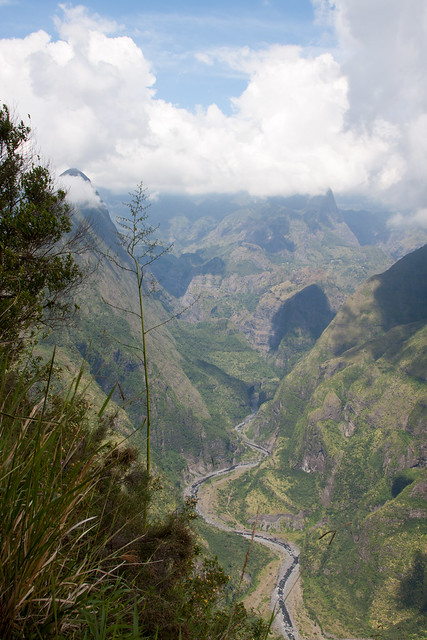

And then you finally turn that last corner to the Cap Noir overlook, and the full view of Dos d'âne and the Cirque is phenomenal. (And your eyes aren't deceiving you, there are a few villages in the Cirque, even though you can generally only reach them after several long and steep hikes):

Leaving from the village of Dos d'ânes high up in the hills, you immediately get a feeling of Reunion's impressive vertical relief, because the trial is on a cliff over the river over 3000' below:


As you hike down the valley on the trail, the view shifts from just the impressive river canyon, and the view of Dos d'âne starts to come into view...


And then you finally turn that last corner to the Cap Noir overlook, and the full view of Dos d'âne and the Cirque is phenomenal. (And your eyes aren't deceiving you, there are a few villages in the Cirque, even though you can generally only reach them after several long and steep hikes):

#15
Original Poster
Join Date: Mar 2008
Location: Grantham, NH
Posts: 530
The other neat thing about being on a tropical island almost halfway around the world is that the plant and animal species are all different. For example, the major types of trees are (a) Palms, (b) tamarinds, and (c) ferns (yeah, some of the ferns grow up to be huge palm-like trees).
And these cool succulents were growing everywhere. Still don't know what they are called (we did go to a botanical garden, but there I learned the limits of my French):

Not sure what these flowers are, either, but they were also everywhere:
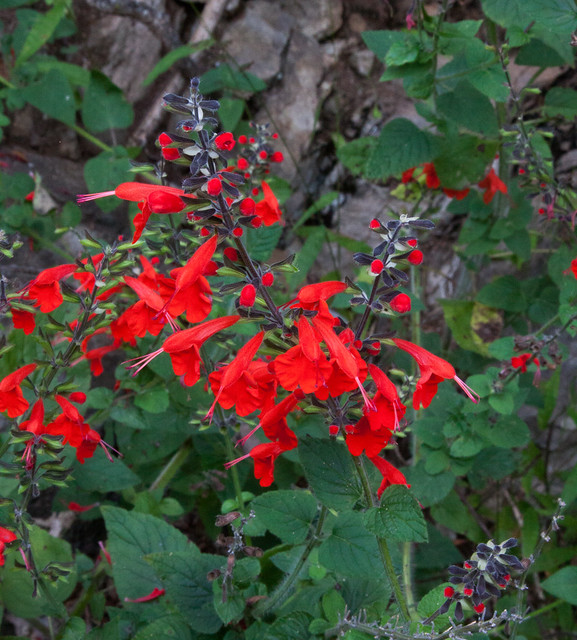
As were these (Carol knew these as some sort of ornamental we can buy at the greenhouse, but I don't remember her answer):
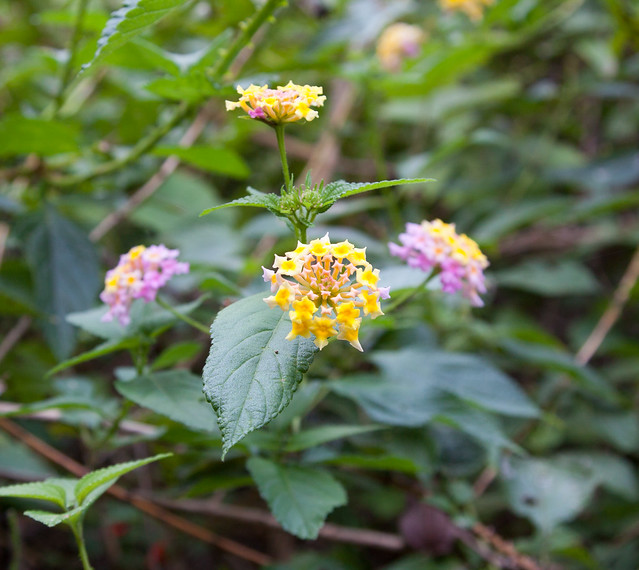
And Reunion has almost no natural predators aside from the Papangue Hawk, so the birds are very, very friendly to people, and you could get all sorts of crazy closeups:
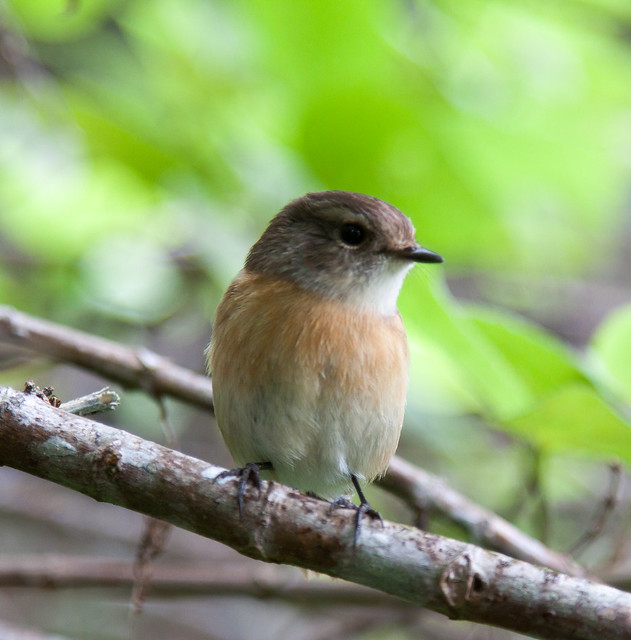
However, some things you don't need to get all that close to. Like this red-footed golden orb spider, which had a foot span of almost 9":
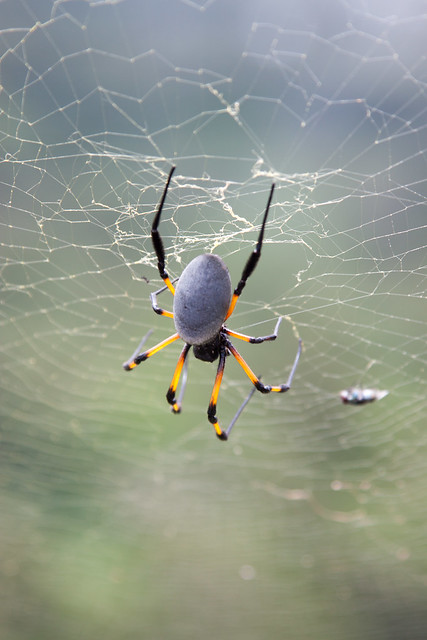
And these cool succulents were growing everywhere. Still don't know what they are called (we did go to a botanical garden, but there I learned the limits of my French):

Not sure what these flowers are, either, but they were also everywhere:

As were these (Carol knew these as some sort of ornamental we can buy at the greenhouse, but I don't remember her answer):

And Reunion has almost no natural predators aside from the Papangue Hawk, so the birds are very, very friendly to people, and you could get all sorts of crazy closeups:

However, some things you don't need to get all that close to. Like this red-footed golden orb spider, which had a foot span of almost 9":






















